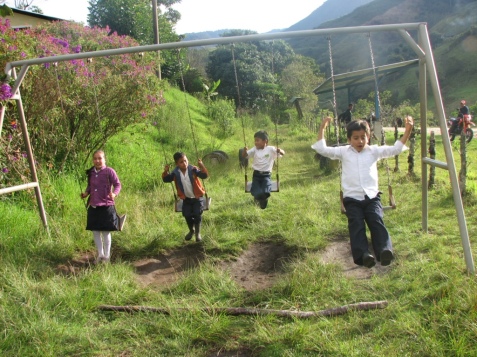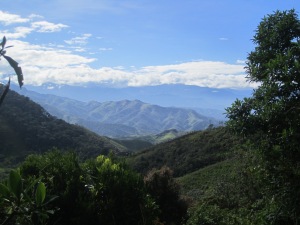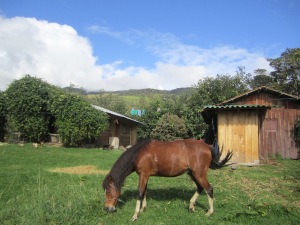« INTAGTOUR » Exposé d’une expérience du bénévolat en Equateur
Mai – Juin 2011
Bethan STACEY
Bien qu’en ayant régulièrement voyagé en dehors de l’Europe, cette période de bénévolat ressort comme une expérience importante. C’était la première fois que j’ai pu réellement échanger et vivre avec les individus d’une, et dans, une communauté extrêmement différente de la mienne, ainsi que participer à la vie quotidienne. En conséquence, je vais souligner plusieurs choses que j’ai apprises sur moi-même et qui m’aideront en tant qu’acteur dans un projet du développement. Sans doute cette expérience aurait été très intéressante et nettement plus révélatrice si j’avais été anthropologue, et je vais tenter d’expliquer comment. Par-dessus tout, j’ai eu l’occasion de faire partie d’un autre système d’éducation. Cela m’a fait questionner beaucoup de choses que j’élaborerai par la suite, et dont certaines que je souhaite aborder dans le mémoire de ce Master 1.
Le contexte du projet Intagtour
Intagtour se situe en Intag, qui est une zone sub-tropicale de la province d’Imbabura en Equateur, au nord de la capitale, Quito. Il s’agit d’une zone de foret montagneuse humide qui est connue pour sa variété de flore et de faune. J’étais basée dans la paroisse de Cuellaje, dans la petite communauté rurale de San Antonio, qui touche la réserve naturelle de Cotacachi-Cayapas.
Les alentours d’Intag ont une population indigène mais Intag elle-même est une zone de mixité ethnique (mestizo). Dans la plupart des cas, ces peuples sont venus s’installer entre 1890s et 1960s en fuyant le travail très dure des importantes exploitations agricoles autour de Quito.
Le projet a un volet écotouristique avec, pour but, de fournir une expérience inoubliable aux voyageurs et écotouristes, grâce à un mélange de nature « intacte » et une interaction culturelle détendue et « authentique ». L’autre volet est celui du bénévolat, ce qui concerne mon expérience. Il en existe trois types : l’enseignement, le travail agricole et celui du travail écologique et de la conservation. L’idée s’agit d’accroitre la confiance des enfants et adultes locaux pour qu’ils connaissent d’autres professions et puissent gagner un revenu des sources qui ne menacent pas leur mode de vie traditionnel. Le projet cible aussi à ralentir la déforestation d’Intag et d’encourager les locaux à réfléchir sur l’exploitation minière de cuivre dans la région, et ses possibles effets à long termes sur les ressources naturelles.
Avant ma participation
A part des raisons pragmatiques liées aux frais, à la flexibilité et à la localisation du projet, j’ai choisi Intagtour pour plusieurs raisons. L’éducation est quelque chose que je tiens au coeur et je voulais être impliquée dans un projet où je pouvais avoir un rôle vraiment utile : je voulais appliquer mes compétences déjà existantes. Je crois que le rôle du professeur est important dans n’importe quelle société. Bien sur j’avais le désir aussi de me dépayser et expérimenter une société très différente, ainsi qu’apprendre la langue Espagnole. Il faut prendre en compte que le mois du bénévolat ne faisait qu’un tiers de mon voyage en Amérique du Sud, où j’étais touriste à la base.
Grâce à mes correspondances avec le directeur du programme, Ned, j’ai compris que mes seules tâches consisteraient en enseigner l’Anglais dans une école primaire et faire d’autres cours selon mes centres d’intérêt et les besoins des professeurs. Les horaires du travail n’étaient pas détaillées et la durée de la participation était selon la disponibilité et la volonté du bénévole avec un minimum d’une semaine. Le logement se faisait selon le ‘feeling’ entre les bénévoles et la famille d’accueil. En bref, la totalité de l’organisation était très flexible et n’exigeait pas un engagement énorme de la part du bénévole.
A propos des locaux, des coutumes, des conditions de vie, de la technologie etc, les photographies et les descriptions du directeur et des anciens bénévoles ne me permettaient pas de les visualiser réellement. Cependant, en arrivant je me suis rendue compte que le lieu et la situation du bénévole étaient plus isolés que ce que j’avais attendu.
La vie d’Intag et les obstacles
C’était la première fois que j’avais ‘vécu’ hors de l’Europe donc j’ai rencontré quelques petites difficultés. Celles-ci existaient à cause de la disparité entre les habitudes et le niveau de confort occidentaux par rapport à ceux de l’Intag. Par exemple, le niveau hygiène et sanitaire, ainsi que la variété de la nourriture et la régularité des repas étaient très contrastés. Cependant, aucunes de ces « difficultés » ne me posaient de grands problèmes car il fallait juste un niveau d’adaptation. En plus la durée n’était pas longue.
L’obstacle le plus grand était celui de la communication verbale limitée. A cause d’un niveau d’Espagnole peu élevé, les échanges étaient moins importants et moins détaillés que je ne l’aurais souhaité. Nous étions limités dans notre appréhension d’un grand nombre de choses pratiques et culturelles, par exemple sur l’école et l’éducation, les activités dans la communauté, et les vues, valeurs et opinions de notre famille d’accueil etc. La situation était donc souvent frustrante et parfois confuse. J’ai aussi constaté que les individus s’adressaient plus à mon compagnon, même si j’avais un Espagnol nettement plus avancé. Peut-être la société était généralement machiste.
Néanmoins, il y avait des éléments facilitateurs dans la communauté. Une professeur en particulier était très facilitatrice. Elle avait déjà vécu de bonnes expériences avec d’autres bénévoles, était assez jeune et venait de l’extérieur. Tout cela pourrait expliquer sa volonté de nous aider. Les enfants nous ont également aidé dans la communication, qui est plus simple en général avec eux. Enfin, pour avoir un peu de contact avec la vie occidentale, une communication facile ou de la traduction le directeur était très disponible.
Le bénévolat et l’école
Dans les écoles primaires de ces communautés, il n’y avait aucun professeur qui pouvait enseigner l’Anglais, même si la langue fait partie du programme scolaire national. En tant que bénévole, j’ai donc fait du soutien scolaire.
Pendant la période du bénévolat, j’ai observé certains phénomènes qui me semblaient inconsistants ou paradoxaux :
Professeurs : Un programme scolaire national existe, ainsi qu’une routine dans l’enseignement, mais les professeurs semblaient les adapter assez librement (et des fois en ignorant qu’ils le faisaient) : la durée des pauses changeaient considérablement d’un jour à l’autre ; certaines activités qui devaient avoir lieu chaque semaine n’ont pas été suivies ; il y a eu des jours de grand changement dans la routine scolaire, et des absences de professeurs qui engendraient la fermeture de l’école ou de classes ; parfois je donnais des cours beaucoup plus longs, ou dans des matières autres que l’Anglais comme les cours de sport et de danse, qui me paraissaient des matières peu favorisées par les professeurs. En outre, malgré les relations apparemment très proches entre enfants et professeurs, la sévérité du professeur et son rapport avec les élèves changeaient selon l’humeur de ce dernier.
En général, le comportement des professeurs me paraissait imprévisible et parfois peu professionnel. Par conséquent, j’ai trouvé assez difficile de comprendre les logiques qui sous-tendaient leurs actions – je ne suis pas arrivée à distinguer entre la personnalité, la culture professionnelle et la culture locale.
« Projet graine » : Un jour, les enfants faisaient du jardinage à l’école. Je croyais qu’il s’agissait d’un caprice des professeurs pour occuper les enfants, mais une professeur m’a expliqué que c’était un projet scolaire national de s’occuper et de cultiver des jardins. D’un cote, je voyais directement la valeur pour les enfants mais de l’autre je trouvais ce scénario bizarre ; ils viennent tous de familles agricoles. Postérieurement, j’ai appris que ce projet a été conçu pour répondre au problème du manque de nourriture dans les zones rurales en Equateur, où les agriculteurs se concentrent sur l’élevage de bétail parce que cela rapporte plus de revenu.
Prise de conscience des problèmes environnementaux : Les enfants d’Intag reçoivent des cours sur la sensibilisation à l’environnement. Par contre, j’ai observé des pratiques qui vont à l’encontre de ma propre conception de ce sujet. Les familles pratiquent l’agriculture sur brulis ou sur abbatis-brulis et empiètent sur le peu de forêt qu’il reste et qu’ils ont le droit de toucher. Il n’y avait pas de déchetterie à San Antonio. Les animaux consommaient tous les déchets biologique mais tout emballage était brûlé, déposé dans un champ derrière la maison, ou en pleine nature où les enfants les laissaient tomber. Enfin, il y avait une poubelle de recyclage à l’école mais les déchets n’étaient pas triés.
Anglais : L’Anglais fait partie du programme scolaire national. Cependant, dans cette école, les professeurs n’étaient pas formés et il n’y avait pas de programme/textes formels à suivre. J’ai donc continué le programme de l’ancien bénévole et organisé son suivi pour que le prochain puisse maintenir un peu de continuité. Il n’était donc pas possible de connaître le programme d’Anglais proposé par l’état, ni les méthodes ou la manière dont les enfants sont sensés l’apprendre.
Méthodes d’enseignement : En général je me suis posée des questions sur l’efficacité de quelques méthodes d’enseignement qu’employaient les professeurs. Par exemple, j’ai observé beaucoup de répétition orale et la duplication de beaucoup de lignes d’écriture, ce qui me paraissait quelque peu dépassé.
Conclusions et questions à la fin du bénévolat
A la fin du bénévolat, j’ai eu l’impression d’avoir contribué à l’éducation des enfants en prenant le relai d’autres bénévoles pour assurer un Anglais plus ou moins continu. Comme les professeurs n’étaient pas qualifiés en Anglais, je n’ai pas eu peur de prendre le travail d’un professeur ‘local’. Les parents des enfants se sont déclarés être vraiment reconnaissants du travail des bénévoles, ainsi que les professeurs. De ce fait, je n’aurais pas pu attendre mieux de mon séjour la-bas. Cependant, j’ai encore beaucoup de questions sur le bénévolat et le développement dans les pays « du Sud », mais surtout sur l’éducation formelle, (et informelle).
Questions sur l’éducation : Dans un pays comme l’Equateur, il y a un énorme décalage entre vie rurale et vie urbaine. Comment les enfants arrivent à concilier ce qu’ils apprennent à l’école qui suit un programme scolaire national, avec une vie rurale? Comment est-ce qu’ils intègrent ces idées concrètement? Est-ce que l’école est adaptée et utile aux enfants qui vont reprendre le terrain et la vie agricole de leurs parents? Mais, est-ce que l’éducation formelle devrait répondre à la vie rurale ou est-ce que ce type d’éducation devrait prendre lieu au sein de la famille, plus informellement? Est-ce que les enfants devraient être préparés à la compétition dans une économie et un marché globale ? Le peuvent-ils, sans dévaloriser leurs propres systèmes de valeurs? Et dans ce cas de figure, où est la place de l’apprentissage de l’Anglais et le travail des bénévoles, dans une zone où il y a très peu de contact et de commerce avec les étrangers ? Surement ils ne devraient pas être restreints par leur éducation ni trop éloignés de la culture de leurs parents.
En bref, l’éducation formelle peut-elle réellement améliorer les vies des personnes pauvres ? Comment ? Et quelles en sont les questions anthropologiques? Quelle est l’importance des méthodes d’enseignement utilisées, de la personnalité des professeurs ou des matières abordées ?
Comment cette expérience m’aidera au début d’une vie professionnelle
Cette expérience m’a permit de légèrement appréhender les conditions que je pourrais affronter dans un projet du développement dans une zone rurale d’un pays « du Sud ». Sur le plan personnel, j’ai pu donc constater comment je fais face à certaines différences et mon niveau d’adaptabilité. Par ailleurs, je comprends l’importance de connaître le mieux possible la langue de la société concernée pour pouvoir échanger efficacement. Par conséquence, en tant qu’acteur dans un projet de développement, je ferai en sorte de travailler dans un milieu où je parle déjà une des langues de la population. Sinon, je ferai tout pour apprendre les bases de la langue et je demanderai un interprète à mes employeurs.
Aussi, la durée de mon séjour d’un mois pourrait ressembler aux contraintes de temps d’une étude anthropologique dans un projet de développement. Même en vivant chez les habitants et ayant un rôle participatif, ce n’est pas évident de commencer à comprendre une société dans un temps aussi court. Je peux donc imaginer la difficulté de cette restriction sur un travail d’anthropologue ou de sociologue dans le développement.
Je réalise que je suis partie assez ‘ignorante’ des conditions de vie, des tâches et attentes de ma participation, ainsi que de la structure même. J’avais essayé de choisir un ‘bon’ projet de bénévolat mais ces choses ne se réalisent pas facilement à distance. Quoiqu’il arrive, dans les projets de développement, il paraît qu’un grand écart existe entre les attentes et les plans des acteurs avant la mise en oeuvre d’un projet, et les réalités sur le terrain. Ceci étant dit, cela ne m’empêchera pas de me renseigner soigneusement sur l’organisation qui mène le projet avant de m’y engager. Enfin, si j’avais été formée en anthropologie avant cette expérience, j’aurais appréhendé les actions des individus, et surtout des professeurs bien différemment. J’aurais tenter d’en découvrir plus sur la conception et la mise en oeuvre du projet, l’implication et la participation des individus de la communauté, les impactes, et la place du directeur dans la communauté. Certainement, j’espérerais avoir moins de questions très larges sur l’éducation formelle, et informelle, dans cette communauté.
Conclusion
Même-si mon implication dans ce projet n’est pas celle d’un acteur de projet de développement, l’expérience m’a servie quand même comme une sorte de terrain d’entrainement, avec tout l’apprentissage que cela amène. Avec la prise de recul et l’application des connaissances que je suis en train d’acquérir grâce à mes études actuelles, j’arrive à contextualiser ce projet dans le domaine du développement, et le voir d’un point de vue plus anthropologique que ce que j’avais à l’époque. Surtout, les questions que j’ai soulevées liées à l’éducation me donne un point de départ pour mes prochaines recherches dans le cadre de mes études.






















